Remote and hybrid work, once a rapid shift, are now key parts of the 2025 professional world. This article offers a clear, data-driven look at current remote work statistics.
We’ll examine demographics, how industry and occupation play a role, current employee preferences, and the main remote work trends shaping this year. Our aim is to give you a concise snapshot, backed by recent research, of where flexible work stands today.
Who is Working Remotely? A Look at Demographics in 2025
The chance of you working remotely in 2025 often links to a few key things about your background. Let’s see who is most often working away from the traditional office.
Education Makes a Difference
Your level of education plays a clear role. You’ll find a much larger share of American employees with an advanced degree (around 42.8% in early 2025) teleworking.
This compares to just 9.1% of high school graduates with no college degree, suggesting knowledge-based roles adapt more easily.
Age and Work Location
Age also shows interesting patterns. The 35 to 44 age group often has the highest rate of remote work. Figures hover around 27.4% for this group, perhaps as they balance established careers and family life, making flexibility particularly useful.
Remote Work Adoption — Which Industries & Occupations Lead in 2025?

Flexible work isn’t spread evenly across all job types or sectors in 2025. Some fields are clearly ahead in offering remote and hybrid arrangements.
Top Industries for Working Flexibly
Certain industries stand out for high rates of remote or hybrid work. You’ll often see sectors like Information, Finance and Insurance, and Professional and Business Services leading the pack.
For instance, it’s common for around 30% of full-time employees in finance and insurance to be working fully remotely, as many tasks are computer-based.
Job Types Most Likely to Be Remote
Looking at specific job functions, tech roles, many marketing positions, and some HR or finance jobs remain strong for remote opportunities.
Even with ongoing return-to-office discussions, a notable portion of new U.S. job postings – often around 10-15% in late 2024 – still mentioned remote or hybrid options. This shows flexibility remains a key factor in hiring for many roles.
Unpacking Remote Work Preferences in 2025
Beyond where remote work can happen, what arrangements do employees themselves actually prefer in 2025? The data consistently shows that flexibility is a major consideration for today’s workforce.
The Strong Desire for Flexible Arrangements
Many surveys reveal a clear employee preference for either fully remote or hybrid work setups. For example, YouGov data frequently indicates that a significant group, often around 36% of U.S. employees, would choose to work from home every day if given the option.
Hybrid arrangements are often the next most popular choice. This ongoing demand for flexibility is definitely shaping how companies approach their work models.
Flexibility’s Impact on Job Choices and Engagement
This desire for flexibility often directly influences career decisions. Research from sources like Gallup or Pew Research consistently highlights that a large number of workers would think about leaving their current job if their remote work options were removed.
Some studies even suggest that hybrid employees often report higher levels of engagement compared to those who are fully on-site. It’s evident that for many people in 2025, having some control over where and when they work has moved from being a simple perk to a core expectation.
Key Remote Work Trends Defining 2025

When you look at all the current data and how work setups are settling in, a few important remote work trends really stand out for 2025. It’s not just about where people are located, but also how organizations are adapting to these new norms.
Hybrid Models Are More Common
Hybrid work is solidifying as the most widespread arrangement. Much research, including work by Stanford economist Nicholas Bloom, indicates that many professionals now typically split their week between home and office.
This often involves about three days in the office, and is becoming a standard way for many businesses to operate.
The Ongoing Flexibility Discussion
However, a key trend for 2025 is the continuing discussion. This revolves around balancing what companies might prefer for in-office presence and what employees want in terms of flexibility.
Data sometimes highlights that remote staff can face disadvantages in areas like promotions, pointing to the challenge of proximity bias. Finding a fair and effective balance remains a major focus.
Better Tools for Distributed Work Still Needed
Finally, there’s a consistent push for improved technology and tools. These are needed to better support this more spread-out way of working. Many (as much as 81%) employees still feel their current remote work tools could be better.
So, you can expect to see ongoing development and adoption of more advanced collaboration and communication platforms designed to make hybrid work smoother and more equitable for everyone involved.
Looking Ahead – Remote Work’s Enduring Influence
The remote work scene in 2025 clearly shows that flexibility is no longer a temporary measure. It has become a lasting part of how we define our professional lives. Strong employee preferences continue to drive the adoption and refinement of hybrid models across a multitude of industries.
While companies and their teams are still navigating the ideal balance for productivity, engagement, and fostering a strong culture, the data points consistently towards a future where adaptable work arrangements are central.









